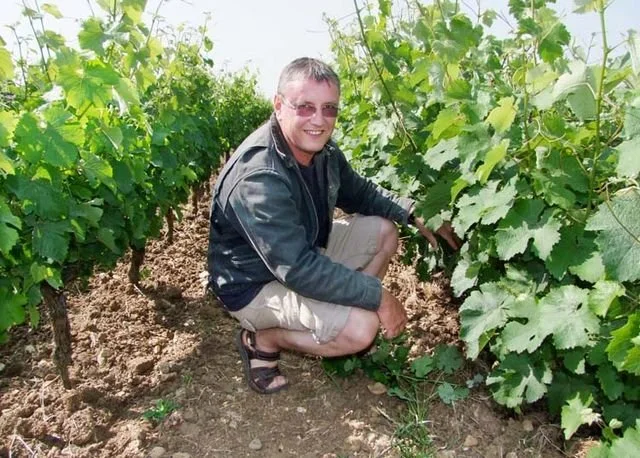A Glimpse into Francois Chidaine
Photo credit: www.wineterroirs.com
We wanted to take a moment to shine a spotlight on a producer we have been working with now for well over a decade or so. He is someone who has long been considered a pioneer in Organic/Biodynamic farming not only in Montlouis-sur-Loire where he really got his start but throughout the Loire Valley as well. If you ever meet him, he will strike you as an independent thinker, a tenacious, focused sort. He is invested in his art and never ceasing to engage with how to improve his grape growing and winemaking methods in a way that is continually in dialogue with nature and how to be better aligned with her.
After viti/enology schooling, he worked alongside his father in the 1980s, who leased a 4 hectare plot in MSL. His father stepped away in 1989, leaving the lease for him to continue. Throughout the early 90s, Chidaine began to work organically and biodynamically, and by 2003 was certified in both (Biodyvin). He is informed most in his Biodynamic understandings and practices from Maria Thun’s Biodynamic Almanac each year. He is now identifying more with regenerative principle of carbon off puts, indigenous plant cover cropping, and no-till practices in farming. He never stops growing, learning, asking the important questions. He was wise to maintain relationships with the original owners so he could eventually purchase his beloved parcels, many he assumed in 2006.
Montlouis sits across from Vouvray on the south side of the Loire. For a long time, MSL sat in teh shadow of its prestigious northerly neighbor. Chidaine helped build the reputation of MSL into what it is today. Where Vouvray is presents a cavernous maze of tuffeau, there is a bit more sand, clay, and flint on the more undulating side of Montlouis. Where both boast a host of Chenin styles (their only permitted grape), MSL is often marked for more fanciful, lighter, wispy yet focused expressions versus the sometimes more weighty and ‘packed’ versions in Vouvray. Andre Jefford more eloquently described MSL as, "It has more resource and texture than tight-muscled, tart-tongued Saumur, but it is less unpredictable and exotic than Vouvray, with a pretty, tender style that is hard to dislike in a successful dry wine."
If you ever wanted to go down a massive flint rabbit hole, as I did this weekend, I recommend reading this piece by Alex Maltman in World of Fine Wine (a British Earth Sciences professor author of Vineyards, Rocks and Soils: A Wine Lover’s Guide to Geology (Oxford, 2018). In short, we have grossly misused flint’s effect on aromatic qualities in wine for far too long, and he is here to explain how flint (essentially little silica skeletons that became an extremely fine grade of crystal), its physical properties, and what that means for the organoleptic experience wine in the glass (or lack thereof).
We digress.
Chidaine holds about 37 hectares now in total — about 20 in MSL, a bit of Vouvray (10 ha) as well as Touraine (7 ha) as well for more value-driven, biodynamic selections. Many of his vines range from 40-80 years old and he maintains low yields in his single vineyard sites (average 35 hl/ha). In the winery he prefers very slow natives ferments in demi-muids in his cool cellar separating not only by vineyard of course but pick dates as well. It was a fascinating experience to walk through his cellar and taste the extreme difference in one parcel picked even a day or two apart. The importance of harvest time never was so clear — furthermore the artistry of balance and intentionally capturing their flavors at different phases to achieve more complexity. He tries to avoid MLF to maintain more energy and precision on the palate.
We gratefully get to see many of these cuvees come through Colorado each year, from the limestone-laden Les Bournais (actually the name for this soil in this area) and the more clay/flint-affected Clos Habert (showing more opulence typically). We currently have the 2020 Clos de Breuil Sec which one of the more revered sites. It sits below Clos Habert and shares a similar soil composition of clay/flint (perruches). Clos de Breuil always displays more focus and dryness than Clos Habert. It is stunningly complex and exemplary of MSL. He has a few other MSL vineyards, but we seldom see them here, and many go into assemblages. One such assemblage is Les Choisilles, which also have in stock (2020) from old vines Les Epinais, La Taille aux Louis, and Clos Renard, named for the high level black flint (choisille). We tend to also see his Vouvray cuvee Les Argiles (40 year old vines on average on clay and limestone) and occasionally his single vineyard Vouvray Clos Baudoin (a very special, tiny 70 year old bush vine site).
One of his best everyday values comes from Touraine appellation, where he pulls from 7 vineyards for his white, red, and rose. We carry his 2021 Sauvignon Blanc. It’s a fantastic, easy pleaser that also reflects his high values in farming and winemaking at a wonderful everyday price.
(Thanks to Winedoctor and Chamber Street wines for some of the more recent data above).
